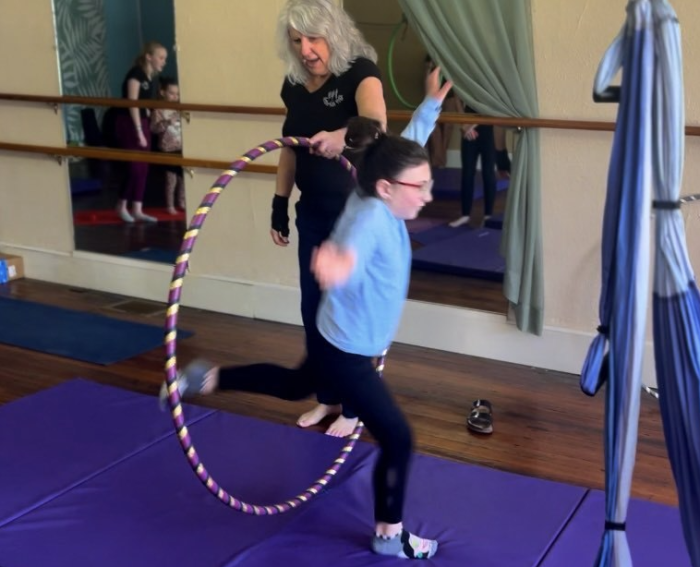{*Did you know you can write on Elephant? Here’s how—big changes: How to Write & Make Money or at least Be of Benefit on Elephant. ~ Waylon}
~
A few years ago, I decided to try using a yoga sling in my yoga therapy practice.
At the time, I thought it would be a good fit for those who wanted the elusive full inversion. I also liked the versatility of the handles. Though the adults enjoyed the aerial yoga classes, it wasn’t until I turned my grandkids loose on the slings that I realized there may be more at work here other than just a fun environment.
I began holding children and youth classes and have invested in more slings, aerial hoops, hula hoops, slacklines, juggling scarves, and much more.
Henry, my youngest grandson, is eight years old and has non-verbal autism. He has never had a fear of climbing and is a master of balance, but his response to our Yoga/Circus classes has been phenomenal!
He loved swinging, spinning, and climbing, however we had a problem. The noise of the class was over stimulating and often he would have to leave. This led me down an incredible path of learning as much as I could about circus yoga for children, particularly those on the autism spectrum.
As a yoga teacher and yoga therapist, I realized that yoga and circus have a lot in common. They are both about body awareness and proprioception. They both involve breathing techniques to quiet the mind and create centering. They both involve focus and concentration.
As a grandmother of an autistic child, I realized that I had to learn more.
The works of Dr. Reg Bolton, a circus clown, educator, and writer who led the charge of working with children, made a significant impact on me, my teachings, and my philosophy. I studied his thesis, “Why Circus Works: How the values and structures of circus make it a significant developmental experience for young people.”
Dr. Bolton explains five keys that make circus successful for all children:
1. It gives them a chance to work hard on skills. Some children with autism may need a “quiet room” for focus and concentration or to help self-regulate if over stimulated. I recommend having sensory toys or sensory videos available.
2. It allows them to take safe risks. Children are encouraged to do what they believe they are capable of with the use of proper safety. My grandson loves to climb, and this is a way to have that outlet for him in a safe environment.
3. It encourages individuality. In the circus, differences are celebrated and encouraged!
4. It helps them work as a team. The human pyramid will not work if we don’t work together.
5. It provides them with the opportunity to have fun. This is the last and most important key. All children deserve to have fun.
In our Adaptive Yoga/Circus class we keep the group small. I take no more than six children, and child has their own Youth Ambassador or certified yoga teacher with them as a companion teacher. Our Youth Ambassadors are responsible, older children in our Youth Aerial Yoga program. This ensures that each child has their own “team,” and it is also a win/win as our autistic children have a mentor and the children in our ambassador program learn about neurodiversity and inclusivity.
Breathing exercises are done with a Hoberman Sphere using the “smell the flower/blow out the candle” technique. If music does happen in class, it is, of course, child friendly and kept at a low volume. If a child is overstimulated, we turn off the music, and if that does not help, they may go with a teacher to the “quiet room” to work.
Children are allowed to make circus animal yoga shapes such as an elephant, lion, or snake on the mat, sling, or lyra. Or they may freelance it. I always let the child take the lead. When working with autistic children, many times it is imitation—seeing their mentor doing it—that leads them to try. If a child does not participate, I just let them be.
Trust the process. I have seen children go from sitting with their parents watching apprehensively to flashing a big smile, kicking off their shoes, and joining in the fun when they are ready. We all start where we are. Many autistic children simply love the “cocooning” of being in the yoga sling because they love the compression. It is important for the child to be able to work within their abilities and yet they are still part of the group and part of the team.
When we allow children to be themselves in a sensory-friendly environment, giving them a chance to explore and develop skills at their own pace, the effects are profound. When a child does something they believe they can’t, it is empowering and exciting and that excitement is infectious for both the teachers and parents.
All children deserve to be able to participate in fun activities in a safe environment. Those with autism are no different. And every parent deserves the chance the post those photos of their child participating on the fridge. Parents of children with autism are no different.
By offering adaptive classes, we give every child and parent that opportunity. And I feel truly blessed and humbled to be their teacher.
~
{Please consider Boosting our authors’ articles in their first week to help them win Elephant’s Ecosystem so they can get paid and write more.}
~












Read 2 comments and reply